5 Best Uses for Wood Pallets 2025
- August 29, 2023
- 0 comment
Ever glanced at those wood pallets piled outside stores and thought they were just junk? Think again! These unsung heroes of the shipping world are goldmines of creativity, waiting to be upcycled into stylish décor and practical masterpieces. Going green has never looked so good! Dive into a world where wooden pallets get a trendy makeover, proving that with a dash of creativity, the ordinary becomes extraordinary. Let’s rediscover the charm hidden in these wooden wonders.
Best Uses for Wood Pallets List:
- Furniture Creations
- Garden and Outdoor Ideas
- Home Décor and Functional Pieces
- For the Kids
- Structures and Larger Projects
1. Furniture Creations
Often, the allure of great design lies in its simplicity and the magic of repurposing. One of the most underrated canvases for this transformation is the humble wood pallet. Here’s a deeper exploration into crafting furniture masterpieces from these ordinary structures.
Pallet Sofa
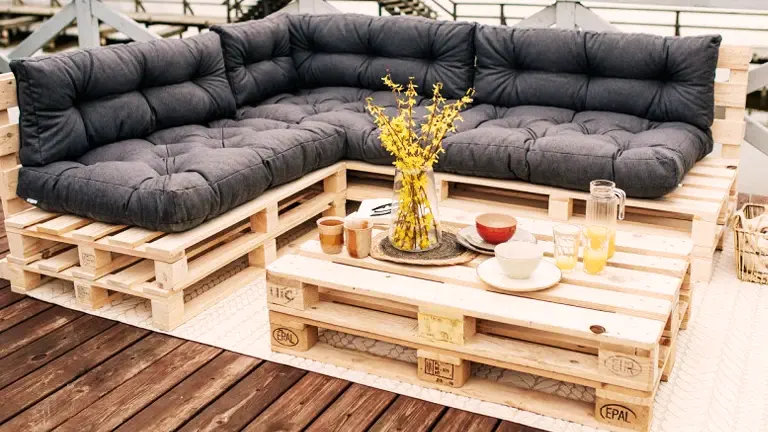
The Pallet Sofa isn’t just a seating arrangement; it’s a statement. This creation embodies a perfect marriage between the ruggedness of the wood and the comfort of the cushions.
- Designing the Look: To begin the transformation, select pallets that have a similar tone and grain. After a thorough cleaning, you can preserve the raw look of the wood for a truly rustic ambiance or choose a paint shade that complements your living area. Soft pastels can add a touch of vintage, while bold hues can turn it into a contemporary masterpiece.
- Comfort is Key: The choice of cushioning can dramatically elevate the sofa’s aesthetics and coziness. Whether you opt for plush, velvety textures or sleek, waterproof outdoor fabrics, ensure the seating is inviting and snug. Throw pillows in contrasting patterns can add layers of visual interest.
Pallet Coffee Table
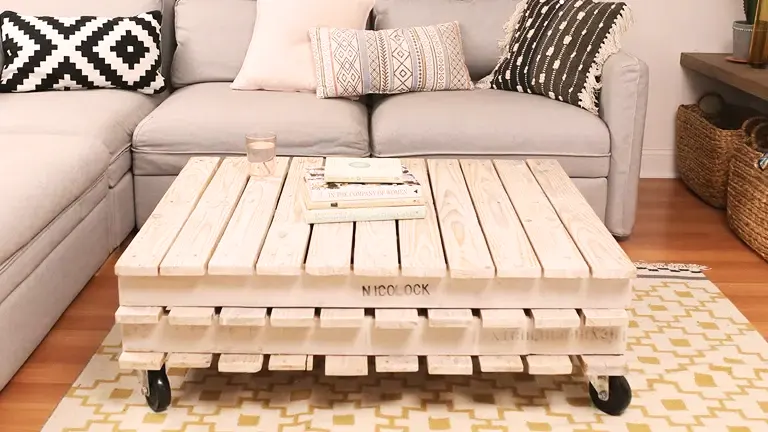
At the heart of many living spaces is the Coffee Table — not just a surface for your morning brew, but a gathering spot, a design anchor. With pallets, this central piece becomes infinitely more intriguing.
- Stack and Style: Begin by stacking two pallets, ensuring stability. This double layer not only adds height but creates niches and shelves for magazines, books, or decor items.
- Functional Flair: Adding caster wheels can make your table mobile, perfect for flexible living spaces. It’s both practical and trendy, lending an industrial edge. As a finishing touch, a glass top can provide a smooth surface, elevating the table’s sophistication while showcasing the character of the wood beneath.
Pallet Bed Base
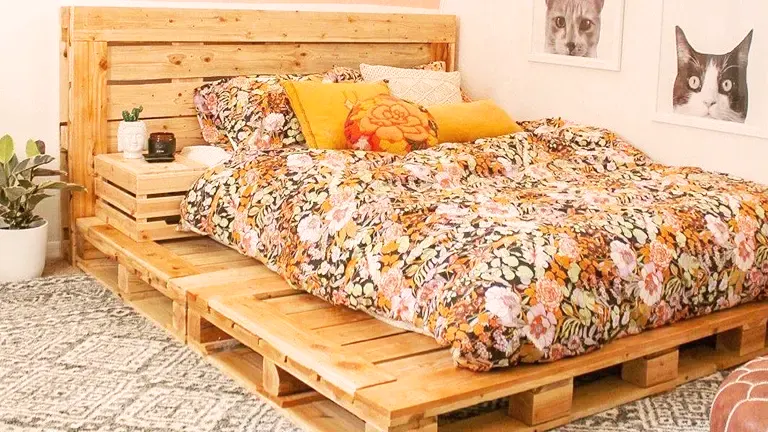
Breaking away from the traditional, the Pallet Bed Base introduces an earthy, Bohemian vibe into the bedroom, grounding your dreams in the embrace of nature.
- Structure and Stability: Laying out pallets to form the base provides an immediate elevation, reminiscent of platform beds. The interlocking wood ensures stability and durability, a crucial aspect of a peaceful slumber.
- Styling Your Sleep Sanctuary: Depending on the desired look, pallets can either be sanded smooth and varnished for a polished appearance or painted to align with the bedroom’s color palette. Incorporating fairy lights around or beneath the base can add an ethereal glow, while draping fabrics can create a canopy effect, transforming the bed into a serene retreat.
2. Garden and Outdoor Ideas
Vertical Garden
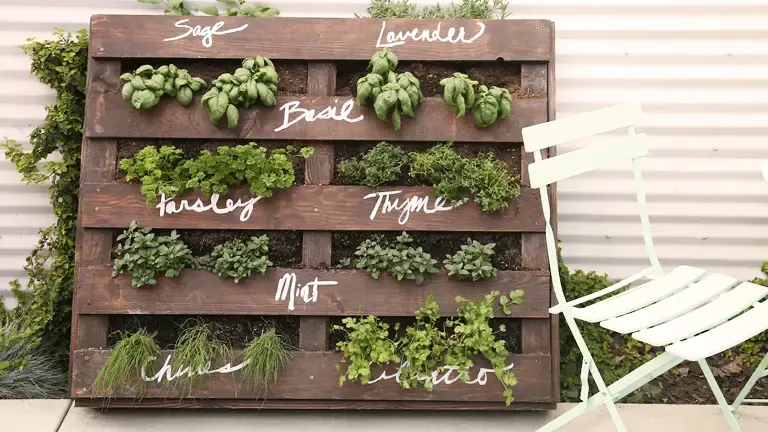
The magic of a Vertical Garden lies in its ability to merge the artistry of arrangement with nature’s beauty. When crafted with a wood pallet, it becomes a masterpiece, a living mosaic of vibrant herbs or intricate succulents.
- Setting the Foundation: To start, fasten a sturdy landscape fabric to the rear side of the pallet. This fabric acts as a barrier, keeping the soil in place while permitting adequate water drainage to prevent root rot.
- Planting the Vision: Once the foundation is set, introduce enriched soil into the pallet’s chambers. Choose plants that are well-suited for vertical growth. Herbs like basil, mint, or rosemary can offer not just visual appeal but also aromatic delight. Alternatively, a range of succulents can introduce a spectrum of textures and shades, creating a dynamic visual display.
- Displaying the Craft: The finished pallet garden can be mounted against a sunlit wall or fence, ensuring that the plants receive their required amount of sunlight. This vertical green tapestry serves as both a functional garden and an enchanting art piece.
Pallet Swing

The Pallet Swing captures the essence of nostalgia and tranquility, allowing one to drift back to cherished memories while leisurely swaying to nature’s rhythm.
- Crafting the Swing: Choose a pallet with strong, undamaged boards. Sanding the wood smooth ensures a splinter-free experience. Whether stained with a natural hue or painted to match patio decor, customization adds a personal touch.
- Ensuring Stability: For the suspension, durable chains or ropes are quintessential. They not only uphold the weight but also add to the swing’s rustic appearance. Ensure that these are securely fastened to the pallet and anchored to a strong beam or sturdy tree branch overhead.
- Accessorizing for Comfort: Top the pallet with plush cushions and throw pillows, inviting one to sink into relaxation. This swing can be the perfect alcove for reading, meditating, or simply soaking in the outdoors.
Compost Bin

Harnessing the simplicity of wood pallets, the Compost Bin is an eco-warrior’s essential, converting organic waste into nutrient-rich compost for gardens.
- Constructing the Bin: Start by selecting three to four similarly-sized pallets. Join them together to form a U-shape, ensuring that there is ample space within for composting materials. If preferred, a fourth pallet can act as a front door, granting easier access to turn and retrieve the compost.
- Aerating the Design: The slatted design of pallets naturally promotes airflow, crucial for efficient decomposition. By periodically turning the compost, you can accelerate the breakdown process and introduce essential oxygen.
- Position and Usage: Place the bin in a location that balances sunlight and shade. Introduce layers of green (nitrogen-rich) and brown (carbon-rich) materials, ensuring balanced decomposition. Over time, this bin will yield a treasure trove of compost, ready to invigorate gardens with vital nutrients.
3. Home Décor and Functional Pieces
Shelving

Pallets, with their robust structure and naturally segmented design, make for distinctive shelving units.
- Construction & Design: Utilizing the full length of a pallet provides a larger shelving space, suitable for books or larger decorative items. For smaller, tiered shelves, you can cut a pallet into desired sections. Depending on orientation, the pallet’s natural spacing can be used to slot books, or horizontally to place decorative items or plants.
- Finish & Aesthetics: Sanding down the wood to a smooth finish is crucial. Depending on your décor style, you can leave it raw for a natural look, varnish for a polished sheen, or paint it to match room colors. Consider adding hooks or knobs for added functionality.
- Styling: Once mounted, style your pallet shelf with a mix of functional and decorative items. For instance, place books interspersed with small plants or knick-knacks for an eclectic mix.
Wine Rack

An ingenious way to celebrate your wine collection is through a pallet wine rack. The inherent design of pallets lends itself well to this transformation.
- Crafting the Rack: For a wine rack, pallets can be repurposed in a vertical orientation. Bottles can be stored horizontally between the pallet’s gaps, while glasses can dangle from the bottom section.
- Customization: Ensure that the pallet sections are wide enough to securely hold the wine bottles. Create notches or attach hooks to the bottom of the pallet to hang wine glasses by their stems.
- Finishing Touches: A dark stain can give the rack an antique feel, while a lighter paint might cater to more modern or minimalistic aesthetics. Adding labels or decorative elements can further enhance its appeal.
4. For the Kids
Wood pallets, usually considered rugged and rustic, can be transformed into delightful play areas that ignite children’s imagination and creativity. Below are some innovative ways to repurpose pallets into playful spaces for children:
Playhouse or Fort

Pallet Playhouses or Forts are where fairytales come alive, where each board and nail is imbued with stories and adventures.
- Building Basics: Depending on the desired size, you’ll need multiple pallets. Start by setting a sturdy base, followed by walls. Consider adding a roof with either more pallet boards or other materials like a tarp for shade. Ensure the edges are smooth, and there are no protruding nails to ensure safety.
- Theme It Up After the basic structure, the real magic begins. Paint it to resemble a medieval castle with battlements, turn it into an intergalactic spaceship with stars and planets, or style it as a charming shop with counters and open windows. Adding decorative elements such as flags, lights, or fabric curtains can enhance its appeal.
- Safety and Longevity: Apply a child-safe, weather-resistant finish to protect the wood and ensure the fort remains a fun haven for years.
Sandbox

Pallet Sandboxes don’t just contain sand; they contain countless tales of buried treasures, masterful castles, and playful moments.
- Creating the Sandbox: Start by choosing a flat area in your yard. Use pallets as the boundary walls, joining them to form a square or rectangle. You can disassemble some pallets and use their boards to create a more polished look or simply join whole pallets for a quicker setup.
- Safety Liner: Before adding sand, lay down a weed barrier or landscape fabric. This prevents unwanted plants from sprouting through the sand while also ensuring the sand remains cleaner by minimizing its contact with the soil below.
- Filling and Fun: Fill the outlined area with play sand, ensuring you leave some depth for digging and building. Consider adding a canopy or umbrella for shade to ensure kids can play even during the sunniest days.
- Additional Touches: Integrate a storage box or bench for sand toys. If you’re feeling more creative, add a lid to the sandbox that can be closed when not in use, keeping the sand clean and free from leaves or other debris.
5. Structures and Larger Projects
Wood pallets, while seemingly humble, possess an innate versatility that makes them ideal for ambitious projects. From decking areas to creating pathways or even building sheds, the potential of pallets goes far beyond simple DIY crafts. Here’s how you can leverage their robustness for larger-scale endeavors:
Decking

Pallet Decking presents an opportunity to create an outdoor oasis without the high costs associated with traditional decking materials.
- Preparation and Layout: Begin by leveling the ground where the deck is intended. Lay out pallets in the desired shape, ensuring they fit snugly against each other. Consider using pallets of uniform size for a cleaner finish.
- Strengthening and Treatment: To enhance the durability, secure pallets together using strong screws. Treat the wood with a weather-resistant sealant to protect against moisture and decay.
- Finishing Touches: For a more polished look, top the pallets with deck boards or outdoor tiles. This not only elevates the aesthetic but also adds a layer of protection to the underlying pallets.
Garden Path

Using pallets to craft a Garden Path is like weaving a story of sustainability amidst nature.
- Disassembly and Preparation: Dismantle pallets into individual boards. Dig a shallow trench in the garden where you wish to lay the path, ensuring it’s leveled.
- Laying the Path: Place the boards side by side, driving them slightly into the soil for stability. Depending on your preference, you can leave spaces between the boards for gravel or moss to grow, adding a more natural transition.
- Protection and Aesthetics: Treat the wood with a sealant suitable for garden use. Over time, the path will adopt a weathered look, blending seamlessly with the garden surroundings.
Pallet Shed

Building a Pallet Shed is a testament to ambition and ingenuity, offering functional storage spaces or serene getaway spots.
- Design and Framework: Draft a basic design for your shed, accounting for the number of pallets required. Start by establishing a strong base, stacking pallets, or using them as joists. The walls are then formed by vertically placing pallets side by side, securing them together and to the base.
- Roofing and Siding: For the roof, you can use pallet wood or other materials such as corrugated metal or shingles. If you seek a more refined appearance, add siding to the exterior using pallet boards or other wood types.
- Doors, Windows, and Treatment: Incorporate a door for accessibility and windows for ventilation and light. Seal the entire structure with weatherproofing treatments, ensuring longevity.
Sustainability at its Best
Repurposing wood pallets isn’t just about saving money or being crafty; it’s about reducing waste and creating sustainable solutions. Every pallet reused is one less item in the landfill and one less new piece of wood that needs to be harvested.
In a world increasingly looking for sustainable and eco-friendly solutions, wood pallets offer a practical and creative resource. From gardens to home décor, the potential for pallets is vast. So, the next time you come across discarded pallets, view them not as waste, but as an opportunity for creation.
Frequently Asked Questions
- What are wood pallets used for?
Wood pallets are used for transporting and storing goods. They provide a stable base for stacking and moving items with forklifts, pallet jacks, and other handling equipment. - What are the advantages of using wood pallets?
Wood pallets are relatively inexpensive, sturdy, and readily available. They are also recyclable and can be repaired or repurposed for various DIY projects. - Are wood pallets standardized in size?
Yes, wood pallets come in standard sizes such as 48″ x 40″. However, there are various sizes and designs to accommodate different industries and transportation needs. - Can I reuse wood pallets?
Yes, wood pallets can be reused if they are in good condition. They can be repaired and refurbished to extend their lifespan. - Can I recycle wood pallets?
Yes, wood pallets can be recycled. They can be broken down into wood chips for mulch, used as fuel, or repurposed for various woodworking projects. - Are there safety concerns when using wood pallets?
Using damaged or broken wood pallets can be unsafe, as they may collapse under heavy loads. It’s important to inspect pallets before use and avoid those with protruding nails, splinters, or other defects. - Can I use any type of wood for making pallets?
Commonly used woods for pallets include pine, oak, and hardwoods. The choice of wood depends on factors like durability, load capacity, and cost. - Are there regulations for exporting goods on wood pallets?
Yes, international shipping regulations, like ISPM 15, require wood pallets to be heat-treated or fumigated to prevent the spread of pests and diseases. - How do I properly dispose of old or unusable wood pallets?
You can recycle old wood pallets through local recycling centers, or repurpose them for DIY projects. Avoid dumping them in landfills. - Can I use wood pallets for indoor furniture or decor?
Yes, wood pallets can be repurposed to create indoor furniture, decor, and other creative projects. However, make sure to sand, clean, and treat the wood properly before use. - Are there alternatives to wood pallets?
Yes, there are pallets made from plastic, metal, and other materials. Each type of pallet has its own advantages and disadvantages. - Can I paint or stain wood pallets?
Yes, you can paint or stain wood pallets to match your desired aesthetic. Just ensure that the paint or stain used is safe for indoor or outdoor use, as needed.
We’re excited to learn from you! Feel free to share your firsthand experiences and ideas about the best uses for wood pallets in the section provided. Your valuable insights could play a significant role in assisting others to make well-informed choices when it comes to maximizing the potential of wood pallets!

David Murray
Forestry AuthorI'm David Murry, a forestry equipment specialist with a focus on chainsaw operation. With over 13 years of experience, I've honed my skills in operating and maintaining a wide range of machinery, from chainsaws to log splitters. My passion for the outdoors and commitment to sustainable forestry drive my work, which emphasizes safety, efficiency, and staying updated with industry advancements. Additionally, I'm dedicated to sharing my expertise and promoting environmental awareness within the forestry community.

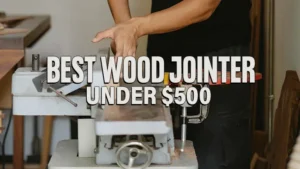











Leave your comment